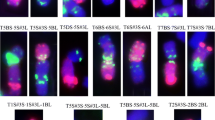Summary
A disomic addition line in which a pair of chromosomes of the tetraploid wild oat Avena barbata have been added to the cultivar Manod is resistant to all the prevalent races of mildew. The gene for mildew resistance is located on the particular A. barbata chromosome involved in the addition line. Seeds of the disomic addition line were irradiated in an attempt to introduce this source of resistance into the cultivated oat by an induced translocation involving the A. barbata chromosome.
A description is given of the method used to isolate a desirable translocation in which the gene for mildew resistance has been introduced into the cultivated oat.
Similar content being viewed by others
References
Aung, T., 1975. Studies of the use of irradiation in the incorporation of alien variation in Avena. M. Sc. Thesis. Univ. Wales.
Aung T. & H. Thomas, 1976. Transfer of mildew resistance from the wild oat Avena barbata into the cultivated oat. Nature 260: 603–604.
Driscoll C. J. & N. F. Jensen, 1963. A genetic method for detecting induced intergeneric translocations. Genetics 48: 459–468.
Hayes J. D. & I. T. Jones, 1966. Variation in the pathogenicity of Erysiphe graminis f.sp. avenae and its relation to the development of mildew resistant oat cultivars. Euphytica 15: 80–86.
Knott D. R., 1968. Translocations involving Triticum chromosomes and Agropyron chromosomes carrying rust resistance. Can. J. Genet. Cytol. 10: 695–696.
Lawes D. A. & J. D. Hayes, 1965. The effect of mildew (Erysiphe graminis f.sp. avenae) on spring oats. Pl. Path. 14: 125–128.
Rajhathy T., 1963. A standard karyotype for Avena sativa. Can. J. Genet. Cytol. 5: 127–132.
Rajhathy, T., F. J. Zillinsky & J. D. Hayes, 1966. A collection of wild oat species in the Mediterranean region. Ottawa Res. Stn Canad. Dep. Agric. 3–25.
Rep. Welsh Pl. Breed. Stn for 1960. p. 46.
Sharma D. & D. R. Knott, 1966. The transfer of leaf rust resistance from Agropyron to Triticum by irradiation. Can. J. Genet. Cytol. 8: 137–143.
Sears E. R., 1956. The transfer of leaf rust resistance from Aegilops umbellulata to wheat. Brook-haven, Symp. Biol. 9: 1–22.
Snow R., 1966. Alcoholic hydrochloric acid. carmine for chromosomes in squash preparations. Stain. Technol. 38: 9–13.
Thomas H., J. M. Leggett & I. T. Jones, 1975. The addition of a pair of chromosomes of the wild oat Avena barbata (2n=28) to the cultivated oat A. sativa L. (2n=42). Euphytica 24: 717–724.
Author information
Authors and Affiliations
Rights and permissions
About this article
Cite this article
Aung, T., Thomas, H. & Jones, I.T. The transfer of the gene for mildew resistance from Avena barbata (4x) into the cultivated oat A. sativa by an induced translocation. Euphytica 26, 623–632 (1977). https://doi.org/10.1007/BF00021687
Received:
Issue Date:
DOI: https://doi.org/10.1007/BF00021687




